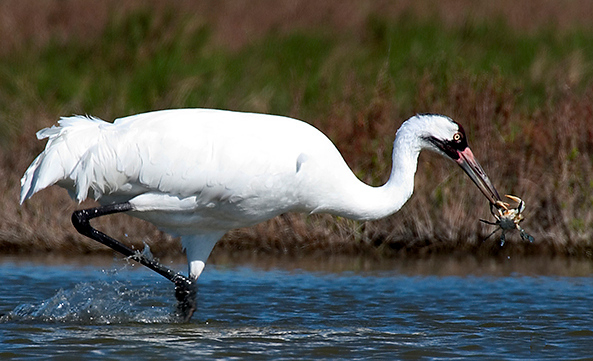
Whooping Cranes are among the most endangered species of birds (photo by Mike Sloat).
|
There are currently three populations of Whooping Cranes in North America, including the primary historic population that migrates from their nesting range centered in Wood Buffalo National Park in the Northwest Territories of Canada, to their wintering area centered at Aransas National Wildlife Refuge in coastal Texas, near Rockport. There are also 2 introduced populations of Whooping Cranes – one migratory population that nests in Wisconsin, and a non-migratory population in Louisiana.
The best information we have about the numerical size of these 3 populations of Whooping Cranes indicates the historic population numbers more than 500, with the last census information indicating 506 Cranes were present in coastal Texas a year ago, in February 2020, including 39 first year Whoopers. There are presently about 100 nesting pairs of Whooping Cranes in this population.
The reintroduced Eastern Population of Whooping Cranes that primarily nests in Wisconsin, numbers 80 this winter, with Whooping Cranes from this population now scattered across a number of wintering sites in several eastern states. Current information indicates that 37 of these Whooping Cranes are currently wintering in Indiana, 11 in Kentucky, 14 in Alabama, 8 in Illinois, 1 in Tennessee, 2 in Georgia, 1 in Florida, and 1 in Michigan, while the location of 5 Whoopers have not been confirmed during the past month. For more information about this population, you can check in at the International Crane Foundation’s website at https://www.savingcranes.org/whooping-crane-eastern-population-update-january-2021/ where you will find more information about Whooping Cranes, and all 15 species of cranes found worldwide.
Although there is little updated information about the reintroduced non-migratory population of Whooping Cranes in Louisiana, the most recent information, dated June 2019, indicated there were 71 Whoopers in that experimental population.
The importance of the reintroduction of Whooping Cranes into other areas of their former range cannot be underestimated, and it is interesting to learn about the progress of these efforts, along with the growing number of Whooping Cranes in the historic Wood Buffalo–Aransas population. Whooping Cranes are long-lived birds that reproduce slowly, however, they have increased dramatically in number from a low population of only 15 birds in 1941, increasing slowly to only 85 in 1984.
Today, with more than 500 Whooping Cranes in the historic population, and about 150 in the two introduced populations, Whooping Cranes have made impressive progress increasing their numbers with the assistance of many dedicated people and the support of the citizens of the United States and Canada. Birders certainly appreciate the majesty of these great white birds, the tallest birds in North American, with one of the broadest wingspans. They are truly magnificent birds that reflect the importance of bird protection, conservation, and management efforts. Anyone seeing a Whooping Crane, or a flock of them, is especially lucky and will probably never forget the experience.